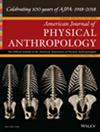以色列Qesem洞穴中更新世牙齿残骸。
IF 2.6
2区 地球科学
Q1 ANTHROPOLOGY
American journal of physical anthropology
Pub Date : 2011-04-01
Epub Date: 2010-12-23
DOI:10.1002/ajpa.21446
引用次数: 126
摘要
本文对以色列Qesem洞穴遗址中更新世恒牙和乳牙进行了描述和比较分析。所有的人类化石都属于下旧石器时代晚期的阿舍洛-亚布鲁德文化复合体(AYCC)。Qesem牙齿的中更新世时代(400-200 ka)使它们的年代比以前在西南亚已知的大部分化石人类标本要早。在层序下部发现3颗恒牙(C(1) -P(4)),排列紧密。小公制尺寸的冠表明相当程度的牙齿减少,虽然根是长而坚固。相比之下,在序列上半部分发现的三颗分离的上颌恒牙(I(2)、C(1)和M(3))和两颗分离的乳牙要大得多,并表现出一些与Skhul/Qafzeh标本相似的紧形特征。虽然没有一颗Qesem牙齿显示出尼安德特人的特征,但一些特征可能表明与尼安德特人进化谱系的成员有一些相似之处。然而,证据的平衡表明,它与Skhul/Qafzeh的牙齿材料更接近,尽管这些相似性中的许多可能代表了似形特征。本文章由计算机程序翻译,如有差异,请以英文原文为准。
Middle Pleistocene dental remains from Qesem Cave (Israel).
This study presents a description and comparative analysis of Middle Pleistocene permanent and deciduous teeth from the site of Qesem Cave (Israel). All of the human fossils are assigned to the Acheulo-Yabrudian Cultural Complex (AYCC) of the late Lower Paleolithic. The Middle Pleistocene age of the Qesem teeth (400-200 ka) places them chronologically earlier than the bulk of fossil hominin specimens previously known from southwest Asia. Three permanent mandibular teeth (C(1) -P(4) ) were found in close proximity in the lower part of the stratigraphic sequence. The small metric dimensions of the crowns indicate a considerable degree of dental reduction although the roots are long and robust. In contrast, three isolated permanent maxillary teeth (I(2) , C(1) , and M(3) ) and two isolated deciduous teeth that were found within the upper part of the sequence are much larger and show some plesiomorphous traits similar to those of the Skhul/Qafzeh specimens. Although none of the Qesem teeth shows a suite of Neanderthal characters, a few traits may suggest some affinities with members of the Neanderthal evolutionary lineage. However, the balance of the evidence suggests a closer similarity with the Skhul/Qafzeh dental material, although many of these resemblances likely represent plesiomorphous features.
求助全文
通过发布文献求助,成功后即可免费获取论文全文。
去求助
来源期刊
CiteScore
4.80
自引率
0.00%
发文量
3
审稿时长
3-8 weeks
期刊介绍:
The American Journal of Physical Anthropology (AJPA) is the official journal of the American Association of Physical Anthropologists. The Journal is published monthly in three quarterly volumes. In addition, two supplements appear on an annual basis, the Yearbook of Physical Anthropology, which publishes major review articles, and the Annual Meeting Issue, containing the Scientific Program of the Annual Meeting of the American Association of Physical Anthropologists and abstracts of posters and podium presentations. The Yearbook of Physical Anthropology has its own editor, appointed by the Association, and is handled independently of the AJPA. As measured by impact factor, the AJPA is among the top journals listed in the anthropology category by the Social Science Citation Index. The reputation of the AJPA as the leading publication in physical anthropology is built on its century-long record of publishing high quality scientific articles in a wide range of topics.

 求助内容:
求助内容: 应助结果提醒方式:
应助结果提醒方式:


